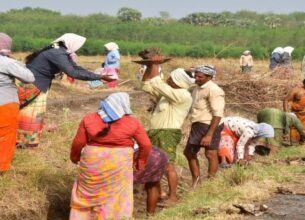The demand for MGNREGS work is unmet
08, Feb 2023

Prelims level : Schemes
Mains level : GS-III Indian Economy and issues relating to planning, mobilization of resources, growth, development and employment.
Why in News?
- A statement by People’s Action for Employment Guarantee and NREGA Sangharsh Morcha has provided an estimate of ₹2.72 lakh crore as the minimum budget required.
About the News:
- The allocation for MGNREGA in the Budget is ₹60,000 crore. This is less than 0.2% of the GDP, the lowest ever allocation as a percentage of GDP.
- World Bank economists had estimated that the allocation should be 1.6% of the GDP. In the last two years, the new financial year began with more than one-fourth of the allocation as pending wages from previous years.
- Assuming a conservative estimate that the next financial year will begin with pending wages of ₹15,000 crore and accounting for inflation, in real terms, the allocation for MGNREGA will be less than ₹45,000 crore.
- A statement by People’s Action for Employment Guarantee and NREGA Sangharsh Morcha has provided an estimate of ₹2.72 lakh crore as the minimum budget required.
- As per this, even ₹1.24 lakh crore can only generate 40 days of work per household per year.
About MGNREGA:
- The scheme was introduced in 2005 as a social measure that guarantees “the right to work”. The key tenet of this social measure and labour law is that the local government will have to legally provide at least 100 days of wage employment in rural India to enhance their quality of life.
Key objectives:
- Generation of paid rural employment of not less than 100 days for each worker who volunteers for unskilled labour.
- Proactively ensuring social inclusion by strengthening the livelihood base of rural poor.
- Creation of durable assets in rural areas such as wells, ponds, roads and canals.
- Reduce urban migration from rural areas.
- Create rural infrastructure by using untapped rural labour.
What are the eligibility criteria for receiving the benefits under MGNREGA scheme?
- Must be Citizen of India to seek MGNREGA benefits.
- Job seeker has completed 18 years of age at the time of application.
- The applicant must be part of a local household (i.e. application must be made with local Gram Panchayat).
- Applicants must volunteer for unskilled labour.
Implementation of the scheme:
- Within 15 days of submitting the application or from the day work is demanded, wage employment will be provided to the applicant.
- Right to get unemployment allowance in case employment is not provided within fifteen days of submitting the application or from the date when work is sought.
- Social Audit of MGNREGA works is mandatory, which lends to accountability and transparency.
- The Gram Sabha is the principal forum for wage seekers to raise their voices and make demands.
- It is the Gram Sabha and the Gram Panchayat which approves the shelf of works under MGNREGA and fix their priority.
What is Democratic Decentralisation?
- Democratic decentralization is the process of devolving the functions and resources of the state from the Centre to the elected representatives at the lower levels so as to facilitate greater direct participation of citizens in governance.
- Devolution, envisioned by the Indian Constitution, is not mere delegation.
- It implies that precisely defined governance functions are formally assigned by law to local governments, backed by adequate transfer of a basket of financial grants and tax handles, and they are given staff so that they have the necessary wherewithal to carry out their responsibilities.
Related Constitutional Provisions:
- Local government, including panchayats, is a state subject in the Constitution, and consequently, the devolution of power and authority to panchayats has been left to the discretion of states.
- The Constitution mandates that panchayats and municipalities shall be elected every five years and enjoins States to devolve functions and responsibilities to them through law.
- The 73rd and 74th Amendments, by constitutionally establishing Panchayati Raj Institutions (PRIs) in India, mandated the establishment of panchayats and municipalities as elected local governments.
- These amendments added two new parts to the Constitution, namely, Part IX titled “The Panchayats” (added by 73rd Amendment) and Part IXA titled “The Municipalities” (added by 74th Amendment).
- The 11th Schedule contains the powers, authority and responsibilities of Panchayats.
- The 12th Schedule contains the powers, authority and responsibilities of Municipalities.
- Article 40: Organization of a village panchayat.







